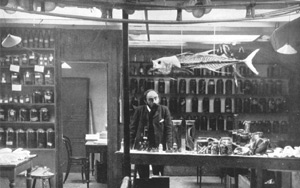
| Glasgow Digital Library | Voyage of the Scotia | BRUCE | PEOPLE | SHIP | ANTARCTIC | INDEX |
|---|

After the voyage of Scotia there was a tremendous amount of material to be sorted, catalogued and analysed. Bruce was anxious to retain the many specimens of Antarctic life, and looked for a suitable base to display the great wealth of specimens.
The eventual site of the Scottish oceanographic laboratory was next to the Royal College of Surgeons in Nicolson Street, Edinburgh. It was opened by the Prince of Monaco on 16 January 1907.
Arctic birds, mammals, a monster sunfish, and oceanographic equipment were all on display. There were sections on the life zones of the southern oceans and pictures of all the Antarctic ships from Challenger onwards. Bruce dreamed of a department in Edinburgh University devoted to oceanography.
Musee Oceanographique
On 28 March 1910 the Musee Oceanographique was opened in Monaco. Bruce had long been a friend of the Prince of Monaco and was at the opening ceremony. The entrance of the museum depicted all the famous Antarctic ships and the proud name of Scotia was there. This museum remains famous today as one of the world's foremost oceanographic research centres. One of the people associated with this centre is Jacques Cousteau, co-inventor of the aqualung and whose TV programmes brought oceanography into people's homes around the world. On 23 January 1911 the teaching Institute of Paris was opened to train new oceanographers. The scientific direction of these new centres was in the hands of noted world oceanographers. The British representatives were J Y Buchanan, Sir J Murray and William Speirs Bruce.
The results from the Challenger expedition took over 20 years to analyse and to be published in 50 volumes. The final results of the Scotia expedition were never completed, although many of the topics covered were published. The main problems revolved around the costs involved in printing and publishing the results.
Bruce had hoped Scotia would be used for a further expedition or for training young oceanographers, but money was required to publish the results of two years of scientific research. Scotia was sold for only £5,000. This was not sufficient to pay for all the publications required.
Bruce has been accused of being better able to spend money than to make money. He made every effort to raise funds by lectures, articles in magazines, the sale of birds and eggs. He managed to raise some money from the Carnegie Trust. Some of the research papers were published by the Royal Society of Edinburgh in their journals.
While Bruce was making every effort to raise funds for the publication of the Scotia results, £20,000 was paid to Shackleton to pay off the Nimrod expedition and £20,000 to the Scott expedition. Bruce applied to the government for £6,800 to complete the results. In the 1910 election all the Scottish MPs were lobbied by the St Andrews Society for support for Bruce. Eventually the prime minister Lloyd George agreed to a £3,000 grant.
Other countries' results were published by their own governments, and the British government paid for results of Scott's expeditions. Why not the Scottish expedition?
The original intention was to publish 12 volumes on the Scotia voyage with articles written by pre-eminent scientists of the day. Only six volumes were published by 1919. Volume 1 was to be the Log of the Scotia, but this was only published in 1992.
Edinburgh Zoo
Many plans were made at the Scottish oceanographic laboratory. Plans for a second Antarctic expedition, the founding of the Scottish Ski Club (Bruce was its first president) and the plans for Edinburgh Zoo. The zoo was opened in Edinburgh. Lord Salvesen was the chairman, William Speirs Bruce vice-chairman and G V Burn-Murdoch the treasurer. Bruce did not live long enough to see the aquarium built.
| Glasgow Digital Library | Voyage of the Scotia | BRUCE | PEOPLE | SHIP | ANTARCTIC | INDEX |
|---|